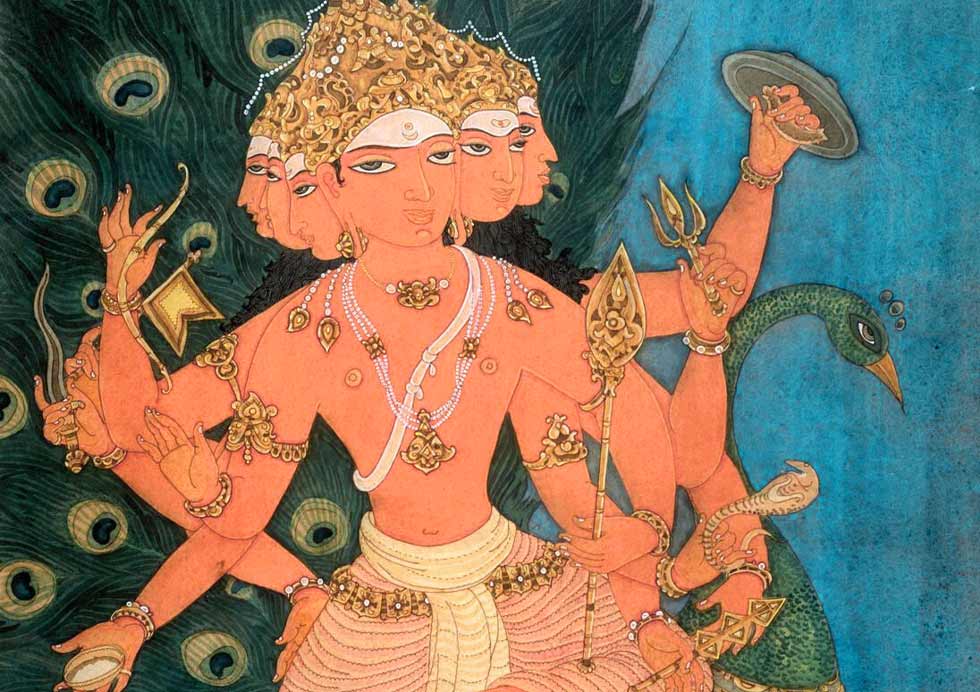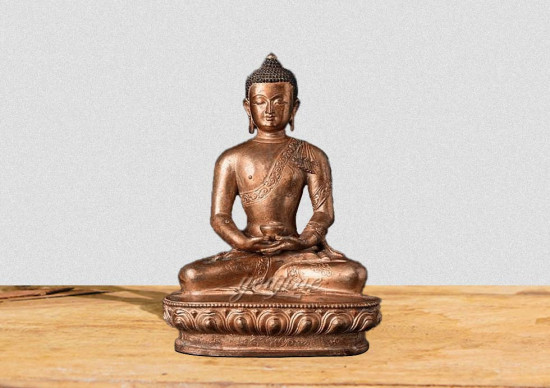
Lord Murugan, also known as Kartikeya, holds a prominent place in Hindu mythology. As the son of Lord Shiva and devi Parvati. Murugan is often depicted as a youthful, powerful warrior god. He is known for his courage, wisdom, and unwavering determination in the face of evil. Murugan is also revered as the god of war, often portrayed holding a Vel, a divine spear that symbolizes victory over demonic forces. There are many temples dedicated to lord Murugan and Palani temple is one of them. The Palani Murugan Temple, located in the serene hills of Palani in Tamil Nadu, India, is one of the most revered temples dedicated to Lord Murugan. Known for its stunning architecture, rich history, and the revered Palani Murugan Idol, this temple draws millions of devotees from all around the world each year.

The Architecture of Palani Murugan Temple

The Palani Murugan Temple, located atop the Sivagiri hill, is a stunning example of early Dravidian architecture with elements that reflect the temple's rich history and spiritual significance. The temple's design seamlessly blends traditional Tamil architectural styles with later influences, making it a unique spiritual and cultural landmark.
The main sanctum of the temple, where the revered Palani Murugan Idol is enshrined, showcases the simplicity and beauty of early Dravidian architecture. The sanctum is encased in a vimanam (a tower above the sanctum) plated with gold, which gleams under the sun, adding to the divine aura of the temple. The vimanam features intricate sculptures of Hindu gods and goddesses, meticulously carved to depict key mythological stories and divine figures, making it a visual representation of the temple's spiritual heritage.
Around the heart of the temple is the first inner prahāram (ambulatory), which contains two minor shrines, one dedicated to Shiva and the other to Parvati, symbolizing the presence of Lord Murugan’s divine parents. These shrines reflect the temple's inclusive nature, offering a space for devotees to honor the family of Murugan.
The walls of the temple are adorned with extensive inscriptions in old Tamil script, offering insights into the temple’s history, its patronage by various dynasties, and the devotion that has shaped it over centuries. These inscriptions are a key source of historical and cultural knowledge, and they provide evidence of the temple’s significance from the Chola, Pandya, and Chera periods.
The influence of the Pandya dynasty is particularly visible in the covered ambulatory around the sanctum, which is a distinctive feature of the temple’s design. This ambulatory not only serves a functional purpose for circumambulation but also adds to the temple's aesthetic grandeur, with its elegant carvings and sculptures.
Within the temple complex, there are several smaller shrines that enrich the spiritual experience. Notably, there is a shrine dedicated to sage Bhogar, who is credited with the creation and consecration of the main idol of Murugan. Bhogar's shrine is an important part of the temple, as he is considered to be a Siddhar and the divine sage whose presence is believed to continue in the temple through his vigilant meditation.
In the second precinct, there is another shrine dedicated to Ganapati, the remover of obstacles, further emphasizing the temple’s focus on removing spiritual barriers for devotees. There are also carriage-houses for the chariots, where the temple’s chariots are stored during festivals, adding to the temple's festive vibrancy and cultural significance.
One of the most remarkable aspects of the Palani Murugan Temple is the sacred path leading up to the hilltop. The 693 steps that lead to the temple are an essential part of the pilgrimage experience. Devotees ascend these steps as an act of devotion, with each step symbolizing a spiritual journey toward Lord Murugan. This physical and spiritual journey is an integral part of the temple’s significance, with many devotees choosing to climb the steps barefoot as a mark of penance and reverence.
Overall, the architecture of the Palani Murugan Temple is a harmonious blend of tradition, devotion, and history, reflecting the divine presence of Lord Murugan and the deep cultural roots of Tamil Nadu. The temple’s majestic structures, sacred shrines, and historical inscriptions create a place where devotees and visitors alike can experience both spiritual growth and cultural enrichment.
The main sanctum of the temple, where the revered Palani Murugan Idol is enshrined, showcases the simplicity and beauty of early Dravidian architecture. The sanctum is encased in a vimanam (a tower above the sanctum) plated with gold, which gleams under the sun, adding to the divine aura of the temple. The vimanam features intricate sculptures of Hindu gods and goddesses, meticulously carved to depict key mythological stories and divine figures, making it a visual representation of the temple's spiritual heritage.
Around the heart of the temple is the first inner prahāram (ambulatory), which contains two minor shrines, one dedicated to Shiva and the other to Parvati, symbolizing the presence of Lord Murugan’s divine parents. These shrines reflect the temple's inclusive nature, offering a space for devotees to honor the family of Murugan.
The walls of the temple are adorned with extensive inscriptions in old Tamil script, offering insights into the temple’s history, its patronage by various dynasties, and the devotion that has shaped it over centuries. These inscriptions are a key source of historical and cultural knowledge, and they provide evidence of the temple’s significance from the Chola, Pandya, and Chera periods.
The influence of the Pandya dynasty is particularly visible in the covered ambulatory around the sanctum, which is a distinctive feature of the temple’s design. This ambulatory not only serves a functional purpose for circumambulation but also adds to the temple's aesthetic grandeur, with its elegant carvings and sculptures.
Within the temple complex, there are several smaller shrines that enrich the spiritual experience. Notably, there is a shrine dedicated to sage Bhogar, who is credited with the creation and consecration of the main idol of Murugan. Bhogar's shrine is an important part of the temple, as he is considered to be a Siddhar and the divine sage whose presence is believed to continue in the temple through his vigilant meditation.
In the second precinct, there is another shrine dedicated to Ganapati, the remover of obstacles, further emphasizing the temple’s focus on removing spiritual barriers for devotees. There are also carriage-houses for the chariots, where the temple’s chariots are stored during festivals, adding to the temple's festive vibrancy and cultural significance.
One of the most remarkable aspects of the Palani Murugan Temple is the sacred path leading up to the hilltop. The 693 steps that lead to the temple are an essential part of the pilgrimage experience. Devotees ascend these steps as an act of devotion, with each step symbolizing a spiritual journey toward Lord Murugan. This physical and spiritual journey is an integral part of the temple’s significance, with many devotees choosing to climb the steps barefoot as a mark of penance and reverence.
Overall, the architecture of the Palani Murugan Temple is a harmonious blend of tradition, devotion, and history, reflecting the divine presence of Lord Murugan and the deep cultural roots of Tamil Nadu. The temple’s majestic structures, sacred shrines, and historical inscriptions create a place where devotees and visitors alike can experience both spiritual growth and cultural enrichment.
Story of Palani Murugan Temple

Long ago, a unique gathering took place at Kailasha, the heavenly abode of Lord Shiva. All the sages and gods had assembled there, and the earth began to tilt under the weight of so many divine beings concentrated in one place. To restore balance, Shiva requested Sage Agasthya to travel south. Agasthya, ever devoted, obeyed.
To assist him, Agasthya sought the help of an asura named Idumban. Idumban was tasked with carrying two sacred hills, Sivagiri (the Mountain of Shiva) and Sakthigiri (the Mountain of Shakti), on his shoulders to the south. As Idumban made his way south, he paused to rest and set the hills down. However, when he tried to lift them again, one of the hills refused to budge.
One day, Sage Narada visited Kailasha and gifted Shiva a special fruit, the gnana-palam or "fruit of knowledge." Shiva, wanting to share it between his two sons, Ganesha and Murugan, was advised by Narada that the fruit could not be divided. Instead, a challenge was set: the fruit would go to the one who could circle the world three times first.
Murugan, eager to win, immediately mounted his peacock and set off on a grand journey around the globe. Meanwhile, Ganesha, wise and thoughtful, realized that his parents, Shiva and Parvati, represented the entire universe. With this understanding, he simply circled them three times and claimed the fruit.
When Murugan returned, tired from his travels, he was devastated to learn that Ganesha had won. Feeling hurt and betrayed, he left Kailasha and took refuge in the serene Palani Hills. There, he renounced his worldly possessions and chose a life of meditation and self-discovery.
To assist him, Agasthya sought the help of an asura named Idumban. Idumban was tasked with carrying two sacred hills, Sivagiri (the Mountain of Shiva) and Sakthigiri (the Mountain of Shakti), on his shoulders to the south. As Idumban made his way south, he paused to rest and set the hills down. However, when he tried to lift them again, one of the hills refused to budge.
Perplexed, Idumban noticed a young boy standing atop the hill. A fierce battle ensued between Idumban and the boy, but Idumban was ultimately defeated. When Sage Agasthya arrived, he recognized the boy as none other than Lord Murugan, Shiva's son. Upon understanding the situation, Murugan allowed the hill to remain where it was. This sacred hill would later become Palani, a place of immense devotion.
The story doesn't end here. Another legend ties Murugan closely to Palani.
One day, Sage Narada visited Kailasha and gifted Shiva a special fruit, the gnana-palam or "fruit of knowledge." Shiva, wanting to share it between his two sons, Ganesha and Murugan, was advised by Narada that the fruit could not be divided. Instead, a challenge was set: the fruit would go to the one who could circle the world three times first.
Murugan, eager to win, immediately mounted his peacock and set off on a grand journey around the globe. Meanwhile, Ganesha, wise and thoughtful, realized that his parents, Shiva and Parvati, represented the entire universe. With this understanding, he simply circled them three times and claimed the fruit.
When Murugan returned, tired from his travels, he was devastated to learn that Ganesha had won. Feeling hurt and betrayed, he left Kailasha and took refuge in the serene Palani Hills. There, he renounced his worldly possessions and chose a life of meditation and self-discovery.
It is said that this act symbolized Murugan's transition from a playful boy to a wise, mature deity. The Palani Murugan Temple, perched on the sacred hill, remains a testament to his divine presence and the deep faith of his devotees.
This temple, rich with legends and devotion, continues to inspire countless pilgrims seeking solace, wisdom, and blessings from Lord Murugan.
The History of Palani Murugan Temple

The History of Palani Murugan Temple is steeped in ancient Tamil traditions and legends, making it one of the most significant Murugan temples in the world. Its roots trace back to the Tamil Sangam period, over 2,000 years ago, reflecting its enduring cultural and spiritual importance.
The Sangam Connection
The temple is mentioned in Sangam literature, such as the Tirumurukāṟṟuppaṭai, where the location is referred to as Thiruaavinankudi. During the Sangam era, the region was called Vaikavurnadu, part of the Vaiyapuri Nadu, and was ruled by Velir chieftains. Poets like Kabilar and Vanparanar celebrated this sacred land in their works. The name "Pothini," derived from the Tamil phrase meaning "the big town with gold," evolved into the modern name Palani.
The Legend of the Idol
The main idol of Lord Murugan in the temple is believed to have been created by Sage Bogar, a revered Siddhar. According to legend, Bogar sculpted the idol using navapashanam, a unique amalgam of nine medicinal herbs. This powerful idol was consecrated in the garbagriha (sanctum sanctorum). Bogar’s devotion to Murugan is said to continue through his eternal meditation in a hidden cave within the hill.
For centuries, the idol was lost in the dense forests surrounding the hill until a Chera king, guided by a divine dream, rediscovered it. Murugan appeared in the king’s dream, urging him to restore the idol. The king built the temple and reestablished worship, beginning the temple’s transformation into a major pilgrimage center.
Contributions of Dynasties
Over time, many rulers contributed to the temple’s development:
- Cholas (10th century CE): Expanded the temple and left inscriptions detailing grants and endowments.
- Pandyas (13th century CE): Further enhanced the temple, with kings like Jatavarman Sundara Pandyan leaving inscriptions about their contributions.
- Vijayanagar Empire (14th-16th centuries): Continued patronage and preservation of the temple.
- Madurai Nayaks: Managed the temple administration through the Palayakkarar system.
Modern History
Under the Mysore kingdom in the 18th century and later during the British Raj, the temple continued to thrive. After India's independence in 1947, it became part of Tamil Nadu and remains a significant religious and cultural landmark.
Spiritual Significance
Palani is one of the Six Abodes of Murugan, celebrated in Tamil literature and hymns such as Thirupugazh by the 15th-century poet Arunagirinathar. The temple not only embodies Murugan’s divine energy but also serves as a place of solace for millions of devotees seeking spiritual guidance.
The temple’s rich history and vibrant legends, combined with its architectural splendor, make it a treasure of Tamil heritage and devotion.
The temple’s rich history and vibrant legends, combined with its architectural splendor, make it a treasure of Tamil heritage and devotion.
Conclusion:
The Palani Murugan Temple stands as a remarkable testament to centuries of devotion, architectural grandeur, and rich historical significance. Nestled atop the sacred Sivagiri hill, this ancient temple continues to attract millions of pilgrims and devotees seeking blessings, wisdom, and spiritual solace from Lord Murugan. The stories of Murugan's triumphs, his deep wisdom, and his unwavering devotion to Lord Shiva resonate with visitors, making the temple not just a place of worship but a profound spiritual journey. From the intricate sculptures adorning the temple walls to the sacred 693 steps leading to the temple, every aspect of the Palani Murugan Temple is a reflection of the deep connection between the divine and the earthly realm. Whether through the legendary stories or the beauty of its architecture, the Palani Murugan Temple remains an iconic landmark in the spiritual landscape of Tamil Nadu and beyond.









